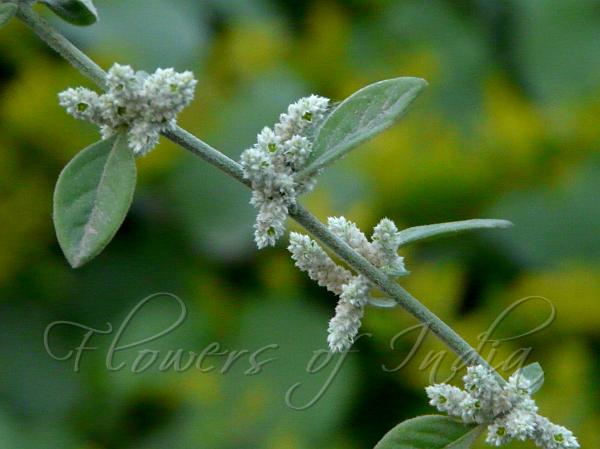|
| Mountain Knot Grass |
|

|

| File size | 653008 |
| Original date | 10/10/09 5:56 PM |
| Resolution | 2560 x 1920 |
| Flash | Flash did not fire, auto |
| Focal length | 23.1mm |
| Exposure time | 1/30s |
| Aperture | 3.6 |
| Focus Distance | |
| Metering Mode | Multi-segment |
| Camera make | Panasonic |
| Camera model | DMC-FZ18 |
| Sensor type | OneChipColorArea |
|
|
|
|
Photo: |
Botanical name: Ouret lanata Family: Amaranthaceae (Amaranth family)
Synonyms: Aerva elegans, Illecebrum lanatum, Aerva lanata
Synonyms: Aerva elegans, Illecebrum lanatum, Aerva lanata
Mountain Knot Grass is a perennial herb, occasionally woody below,
prostrate to erect, 0.3-2 m, branched from the base and often also from
above. Stem and branches are densely woolly with whitish or yellowish,
shaggy hairs. Alternately arrange leaves are nearly circular to
lanceshaped-elliptic, wedge-shaped at the base, rounded to sharp at the
tip. Leaves are usually densely woolly on the lower surface and more
thinly so above. Leaves on the main stem are 1-5 cm long, 0.5-3.5 cm wide,
those of the branches and upper part of the stem are smaller. Leaf stalks
are up to 2 cm. Flower spikes are stalkless, solitary or usually in
clusters in leaf axils, 0.4-1.5 cm long, 3-4 mm wide, divergent,
cylindrical, silky white to creamy, forming a long inflorescence leafy to
the ultimate spikes.
Medicinal uses: This herb is described as one of the best known
remedies for bladder and kidney stones. Ayurvedic practitioners recommend
a decoction of the plant to be taken internally for a few days to
dissolves the stone and to clear the urinary path.
This herb is described as one of the best known
remedies for bladder and kidney stones. Ayurvedic practitioners recommend
a decoction of the plant to be taken internally for a few days to
dissolves the stone and to clear the urinary path.
Medicinal uses:
 This herb is described as one of the best known
remedies for bladder and kidney stones. Ayurvedic practitioners recommend
a decoction of the plant to be taken internally for a few days to
dissolves the stone and to clear the urinary path.
This herb is described as one of the best known
remedies for bladder and kidney stones. Ayurvedic practitioners recommend
a decoction of the plant to be taken internally for a few days to
dissolves the stone and to clear the urinary path. | Identification credit: Tabish | Photographed in JNU campus, Delhi & Maharashtra. |
• Is this flower misidentified? If yes,